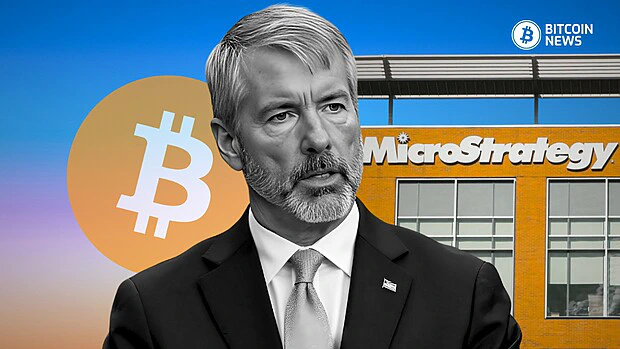Michael Saylor, the founder and executive chairman of MicroStrategy, has become one of the most prominent figures in the Bitcoin world due to his company’s aggressive and unwavering commitment to Bitcoin.
With over 252,000 BTC in its reserves, MicroStrategy has invested around $16 billion into the digital asset. Saylor recently unveiled that his ambition is to transform his company into the world’s leading Bitcoin bank, and he’s making big moves to achieve this vision.
Saylor’s bold plans for MicroStrategy’s future center around bitcoin’s long-term value. According to him, Bitcoin is not only a top-performing asset but also a revolutionary force in the financial world.
His ultimate goal is for MicroStrategy to grow into a trillion-dollar company driven by the potential of Bitcoin. Saylor stated during a fireside chat hosted by Bernstein:
“This is the most valuable asset in the world. The end game is to be the leading Bitcoin bank or merchant bank, or you could call it a Bitcoin finance company.”
He added, “If we end up with $20bn of converts, $20bn of preferred stock, $10bn of debt and say $50bn billion of some kind of debt instrument and structures instrument, we’ll have $100-$150bn of bitcoin.”
Saylor sees Bitcoin as much more than just a digital currency; he views it as a cornerstone of a new financial system. In his eyes, bitcoin’s scarcity and volatility make it a superior asset for hedging against inflation and storing value, especially compared to traditional fiat currencies.
He predicts that by 2045, bitcoin will make up 7% of the world’s total financial capital, a significant jump from its current 0.1%. At that point, he expects the price of bitcoin to reach an astonishing $13 million per coin.
According to Saylor, Bitcoin has the potential to outshine almost every other investment option.
He has built his company’s strategy on this belief, issuing debt to buy more bitcoin in anticipation of its long-term price appreciation. As of now, MicroStrategy’s stock has become a de facto proxy for bitcoin, rising significantly as the value of bitcoin increases.

Saylor explains his reasoning, stating:
“My view is that it’s much more intelligent to borrow a billion dollars from the fixed income market and lend it to bitcoin at a 50% ARR, with no counterparty risk, than to reverse that and find someone willing to pay me 12%-14%,”
In other words, Saylor believes that lending to bitcoin itself, by investing in it, offers better returns than lending to traditional institutions like corporations or governments, which come with added risks.
Saylor is adamant that Bitcoin is not just a passing trend but the birth of a new asset class. “It’s the first time in 100 years that we’ve actually had a new asset class and a new way to think about money and capital that’s being embraced by the regulators,” he said.
He believes Bitcoin is gaining legitimacy as more financial institutions and regulators embrace the digital currency.
He highlighted: “I don’t have any problem seeing how we could raise $100bn more capital and then $200bn after that. It’s a trillion dollar asset class going to $10tn and then going to $100tn. The risk is very simple — it’s bitcoin. You either believe bitcoin is something, or you believe it’s nothing.”
This momentum, according to Saylor, marks the beginning of a “digital gold rush” set to start in 2025. He argues that investors will have about 10 years to buy bitcoin before it’s mostly unavailable on the open market.
By 2035, he predicts that 99% of all bitcoin will have been mined and sold, leaving only 1% trickling out over the following 106 years. This creates a sense of urgency for those looking to invest.
What makes MicroStrategy stand out from other companies involved in Bitcoin is its unique approach. While many companies, like Marathon and Block, include bitcoin in their treasury strategies, MicroStrategy’s focus and scale make it a trailblazer.
Saylor has outlined a clear vision for the future, one that involves MicroStrategy using capital markets arbitrage to borrow money at low-interest rates and invest in bitcoin.
Related: MicroStrategy is Now A “Bitcoin Development Company” | Saylor
The company doesn’t plan to lend out its bitcoin, as a traditional bank might. Instead, MicroStrategy aims to generate returns by holding bitcoin and borrowing money to invest more in the digital asset.
Peter Schiff, a well-known economist and critic of Bitcoin, recently took to social media to mock Saylor’s strategy. Schiff suggested that MicroStrategy should borrow another $4.3 billion to buy Bitcoin that the U.S. government plans to sell after seizing it from the Silk Road.

Schiff has long been critical of Saylor’s approach, accusing him of gambling with shareholder funds. Despite these criticisms, Saylor’s strategy has led to a 1,208% increase in MicroStrategy’s stock since August 2020, even though bitcoin itself has risen by a comparatively modest 445%.
“Every once in a while, the government does something smart. I think Michael Saylor should have MicroStrategy borrow another $4.3 billion and buy it,” Schiff said.
Saylor’s plans are not without their risks. MicroStrategy has accumulated substantial debt in its pursuit of bitcoin, with around $4 billion in debt against its total bitcoin investment of $9.9 billion.
Despite this, Saylor remains confident that the returns will more than justify the strategy. He expects bitcoin to offer an annual growth rate of around 29%, which would help MicroStrategy outperform traditional investments.
Moreover, the political landscape appears to be shifting in favor of Bitcoin.
The approval of Bitcoin exchange-traded funds (ETFs) in the U.S. and the increasing embrace of Bitcoin by political figures, such as presidential candidate Donald Trump, are seen as important steps toward further institutional adoption.
Trump has even pledged to establish a national strategic bitcoin reserve if elected president, adding momentum to the growing acceptance of the scarce digital asset.
Looking forward, Saylor’s vision for MicroStrategy is ambitious but clear. He plans to issue various financial instruments tied to Bitcoin, such as equity and convertible debt, to further embed the company in the emerging Bitcoin economy.
His ultimate goal is for MicroStrategy to become the leading Bitcoin bank, revolutionizing the financial landscape with a model that blends traditional capital markets with the growing Bitcoin economy.
In Saylor’s view, Bitcoin represents the future of finance, and he’s betting that MicroStrategy will lead the charge in this new era.
Only time will tell if his vision will become reality, but for now, Saylor remains committed to his strategy, even in the face of criticism. As he once said, “You’re watching the birth of a new asset class,” and he’s determined to be at the forefront of this financial revolution.










